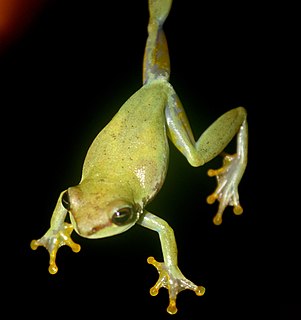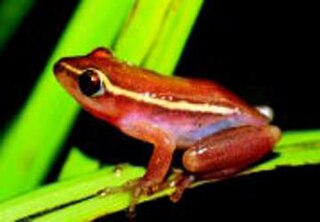Afrixalus lacteus is a species of frog in the family Hyperoliidae. It is endemic to Cameroon and known from a few mountains in the western part of the country; specifically, it has been recorded from Mount Manengouba, Mount Nlonaka, and the southern Bamileke Highlands. Common name Cameroon banana frog has been coined for it. Prior to its description, it was confused with Afrixalus lindholmi.

Hyperolius acutirostris is a species of frog in the family Hyperoliidae. It is endemic to southwestern Cameroon, found as far east as the region of Yaoundé. Common name sharpsnout reed frog has been coined for it.
Hyperolius balfouri is a species of frog in the family Hyperoliidae. It is found in Cameroon, Central African Republic, northeastern Democratic Republic of the Congo, South Sudan, southwestern Ethiopia, Uganda, and western Kenya. The specific name balfouri honours J.W. Balfour, a missionary in Uganda. Common names Balfour's reed frog and Ethiopia reed frog have been coined for this species, with the latter name referring to the now-synonymized Hyperolius zavattarii. Populations from the western part of the range may be referred to the subspecies Hyperolius balfouri viridistriatus.
Hyperolius bolifambae is a species of frog in the family Hyperoliidae. It is known from southeastern Nigeria, southern Cameroon, and southwestern Central African Republic, with an isolated record in northeastern Democratic Republic of the Congo ; the latter record may be considered doubtful. It likely has a broader range towards south and east than currently documented, and the AmphibiaWeb includes Gabon and the Republic of the Congo in the distribution.
Hyperolius bopeleti, also known as the Dizangue reed frog or Bopelet's reed frog, is a species of frog in the family Hyperoliidae. It is endemic to the coastal southwestern Cameroon. The specific name bopeleti honours M. Bopelet, a Cameroonian biologist.
Hyperolius camerunensis is a species of reed frog in the family Hyperoliidae. It is endemic to western and southwestern Cameroon.

Hyperolius castaneus is a species of frogs in the family Hyperoliidae. It is found in the highlands of western Burundi, Rwanda, and Uganda as well as eastern Democratic Republic of the Congo. Common names of this species include Ahl's reed frog, brown reed frog, and montane reed frog. The status of the putative subspecies Hyperolius castaneus rhodogaster is unclear, and it may actually be a distinct species. Also Hyperolius constellatus, now a distinct species, was formerly recognized as a subspecies of H. castaneus.

Hyperolius concolor, also known as the variable reed frog or Hallowell's sedge frog, is a species of frog in the family Hyperoliidae. It occurs in West and Middle Africa.
Hyperolius dintelmanni is a species of frogs in the family Hyperoliidae. It is endemic to Cameroon and found in the montane southwestern part of the country. Specifically, it has been recorded from the Bakossi Mountains, including the Edib Hills and Mount Kupe. The specific name, dintelmanni, honors Mr. Horst Dintelmann from Germany in recognition of "his support of taxonomic research and forthcoming conservation projects in Cameroon".

Hyperolius fusciventris is a species of frog in the family Hyperoliidae. It occurs in West and Middle Africa between Sierra Leone in the west and western Cameroon in the east. Common name lime reed frog has been coined for this species.
Hyperolius igbettensis is a species of frog in the family Hyperoliidae. It is found in West Africa from Guinea eastward to Liberia, Ivory Coast, Ghana, Togo and Benin, Nigeria, and into Central Africa at least to Cameroon but likely further east to the Central African Republic and southwestern Chad; the eastern border of distribution of this species relative to other members in the Hyperolius nasutus complex is unclear. Common name Igbetti long reed frog has been coined for it. The type locality is near Igbetti, a village in Oyo State, Nigeria.
Hyperolius kuligae is a species of frog in the family Hyperoliidae. It is found in southwestern Cameroon, Gabon, and Equatorial Guinea and eastward to the central Democratic Republic of the Congo; it probably occurs in northern Republic of the Congo and the Central African Republic too. It is also reported from Uganda, but the status of this population is unclear. The specific name kuligae honours Paul Kuliga (1878–1948), a physician who joined an expedition to Cameroon in 1936. Common names Camp Kivu reed frog and Kuliga reed frog have been proposed for it.

Hyperolius nasutus is a species of frog in the family Hyperoliidae. Common names include long-nosed reed frog, sharp-nosed reed frog and long reed frog. It is known from northern Angola and northern Botswana, but it presumably occurs more widely. The nominal Hyperolius nasutus was partitioned in 2013 into three cryptic species, the other two being Hyperolius viridis and Hyperolius microps. All these species are members of the so-called Hyperolius nasutus species group, the "long reed frogs".
Hyperolius nitidulus is a species of frog from the family Hyperoliidae. It is found on the West African savannas between Guinea and Mali in the west and Nigeria and Cameroon in the east. Common name plain reed frog has been coined for it.

Pickersgill's reed frog is a species of frog in the family Hyperoliidae. It is endemic to South Africa. It occurs in the coastal lowlands of KwaZulu-Natal between Sezela and St Lucia.

Hyperolius semidiscus is a species of frogs in the family Hyperoliidae. It is found in southern and eastern South Africa and in Eswatini, and it is likely to be present in Mozambique. Common names yellow-striped reed frog, yellow-flanked reed frog, and Hewitt's reed frog have been coined for it.

Hyperolius spinigularis is a species of frog in the family Hyperoliidae. It is found in the Mulanje Massif in southern Malawi and the Namuli Massif in adjacent Mozambique. Records from Tanzania refers to other species. Males of this species have characteristic small spines during the breeding season. Its common names are spiny-throated reed frog, spiny reed frog, and Mulanje reed frog.
Hyperolius sylvaticus is a species of frog in the family Hyperoliidae. It is found in southern Ivory Coast, Ghana, Togo, Nigeria, and western Cameroon, with a gap in Benin. It is also likely to occur in Liberia. Common name Bobiri reed frog has been coined for this species.

Hyperolius tanneri is a species of frogs in the family Hyperoliidae. It is endemic to the West Usambara Mountains in northeastern Tanzania. Common name Tanner's reed frog has been coined for this species.
Hyperolius thomensis is a species of frog in the family Hyperoliidae. It is endemic to the island of São Tomé in São Tomé and Príncipe. Common names São Tomé reed frog, São Tomé giant reed frog, and Sao Tome giant treefrog have been coined for it. It is the largest Hyperolius species.









